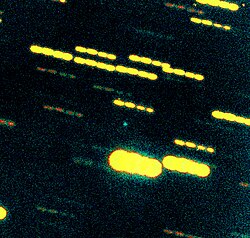46P/Wirtanen
| 46P/Wirtanen | |
 | |
| Upptäckt | |
|---|---|
| Upptäckare | Carl Alvar Wirtanen |
| Upptäcktsdatum | 17 januari 1948 |
| Beteckningar | |
| Officiell beteckning | 1961 IV; 1960m; 1967 XIV; 1967k; 1974 XI; 1974i; 1986 VI; 1985q; 1991 XVI; 1991s; 46P/1948 A1; 1947 XIII; 1948b; 46P/1954 R2; 1954 XI; 1954j |
| Kometkategori | Kortperiodisk |
| Omloppsbana | |
| Epok: 3 september 2002 | |
| Aphelium | 5,129946 AU |
| Perihelium | 1,0587602 AU |
| Excentricitet | 0,6578412 |
| Siderisk omloppstid | 5,44 år |
| Inklination | 11,73813° |
| Förra perihelium | 12 december 2018 |
| Nästa perihelium | 19 maj 2024[1] |
| Hitta fler artiklar om astronomi med | |
46P/Wirtanen är en kortperiodisk komet som har en omloppstid på 5,4 år. Den upptäcktes av den amerikanske astronomen Carl Alvar Wirtanen den 17 januari 1948. Den tillhör Jupiters kometfamilj, som har aphelieavstånd på 5-6 AU. Dess diameter har beräknats till 1,2 kilometer.
Kometen var det ursprungligen tänkta målet för rymdsonden Rosetta, men krångel med startraketen ledde till att lanseringsfönstret missades och istället utsågs kometen 67P/Churyumov-Gerasimenko som mål.[2][3]
Referenser
Noter
- ^ Seiichi Yoshida (15 september 2019). ”81P/Wild 2” (på engelska). http://www.aerith.net/comet/catalog/0046P/index.html. Läst 10 december 2020.
- ^ S. Ulamec, S. Espinasse, B. Feuerbacher, M. Hilchenbach, D. Moura, H. Rosenbauer, H. Scheuerle, R. Willnecker (april 2006). ”Rosetta Lander—Philae: Implications of an alternative mission” (på engelska). Acta Astronautica 58 (8): sid. 435–441. doi:.
- ^ Kathrin Altwegg, Wesley T. Huntress, Jr (2001). ”The constituents of cometary nuclei” (på engelska). The Century of Space Science. Kluwer Academic. sid. 1280. ISBN 0-7923-7196-8. https://books.google.com/books?id=6aQRBwAAQBAJ&pg=PA1280&lpg=PA1280. Läst 5 oktober 2016
| ||||||||
Media som används på denna webbplats
Författare/Upphovsman: ESO, Licens: CC BY 3.0
The image reveals a false-colour composite image of the nucleus of Comet Wirtanen (the point of light at the centre), recorded on December 9, 2001, with the FORS2 multi-mode instrument at the 8.2-m VLT YEPUN Unit Telescope. It is based on four exposures and since the telescope was set to track the motion of the comet in the sky, the images of stars in the field are seen as four consecutive trails.
The measured brightness and the fact that the image of the comet's 'dirty snowball' nucleus is almost star-like indicates that it is surrounded by a very small amount of gas or dust. The diameter of the nucleus is about 1 km and the distance to the comet from the Earth was ~534 million km.
The comet was located in the southern constellation of Sagittarius, rather low over the western horizon. The first two exposures were made through a standard R-filter and lasted 300s each (airmass 2.4 - 2.5); they were followed by two V-exposures of 250 (airmass 2.7) and 200 (2.8) seconds, respectively. The seeing at this low altitude was 1.0 - 1.2 arcsec. The measured magnitudes of the nucleus were R = 22.6 and V = 23.4 (both ± 0.1). North is up and east is to the left. The field measures approx. 2.0 x 2.0 arcmin 2 ; 1 pixel = 0.2 arcsec.